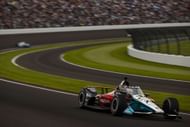IndyCar and Indianapolis Motor Speedway president Doug Boles has set a tentative deadline for unveiling the new 2028 chassis to the public. In June this year, the premier American open-wheel racing series announced that it would introduce a new chassis in 2028 to replace the Dallara DW-12, which has been in play since 2012.
The series will continue working with Dallara on the new chassis, which is expected to weigh 85-100 pounds less. That would majorly offset the 100-odd-pound weight of the new hybrid power units, which were introduced in mid-2024, led by Honda's request for modernization of the engines.
While IndyCar will continue with its hybrid PUs into the new technical era, it will upgrade from a 2.2-litre twin-turbo V6 engine to a 2.4-litre twin-turbo V6 ICE, offering drivers more torque and power. Another major change would be the gearbox shedding 25 pounds to make the car more nimble. And on the safety side, the new chassis will have an integrated aeroscreen instead of a retrofitted one.
During a two-day test at the IMS earlier this week, Doug Boles fielded several questions about IndyCar's future. One of them was about the current state of the 2028 technical program.
"We gave the team owners an initial look at the car in October of last year, and then we had another opportunity with team owners and team managers to take a look at it (during recent meetings)," Boles said via IndyCar. "I think we’ll get it finalized (and) be public with it hopefully before (the first quarter of 2026), and hopefully (soon after) we’ll be able to have a car for people to see. Then we can start testing it next summer."
IndyCar tested new parts for the 2028 car with Alexander Rossi and Takuma Sato during IMS test

IndyCar tested new parts for the 2028 chassis during the two-day test at the Indianapolis Motor Speedway on Tuesday and Wednesday. While Alex Palou and Pato O'Ward tested new tire compounds as part of Firestone's tire development program, Alexander Rossi and Takuma Sato tested new brake calipers and damper components.
O'Ward and Palou had a one-day job, after which they left, while the other two drivers, both Indy 500 winners, continued on Wednesday. Sato, who was testing with Rahal Letterman Lanigan Racing, was impressed with the new brakes.
"This was an enormous success," Sato said. "After 20 laps, the brakes were still there. We used to have to pump the pedal. Not anymore. It gives great confidence and stability."
Alexander Rossi seconded the sentiment, describing how the new parts got rid of brake drag and made the braking smoother. Doug Boles shared that the series could bring spec dampers to the new chassis. Though that has yet to be confirmed, if done, it would make IndyCar more of a spec series, with dampers currently being one of the biggest areas teams innovate around.
Stay updated with the 2025 IndyCar schedule, standings, qualifying, results today, series news, and the latest IndyCar racing news all in one place.
